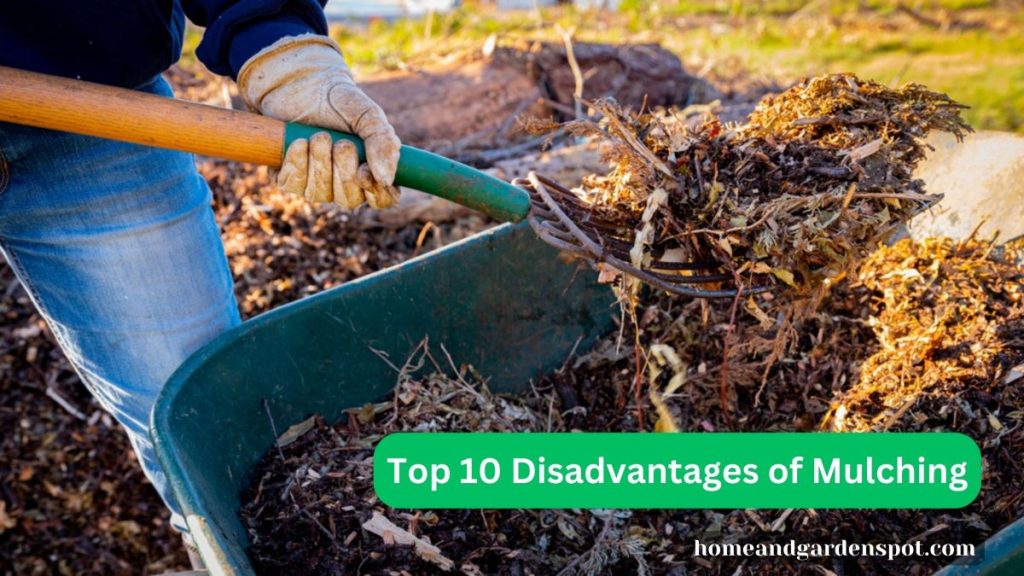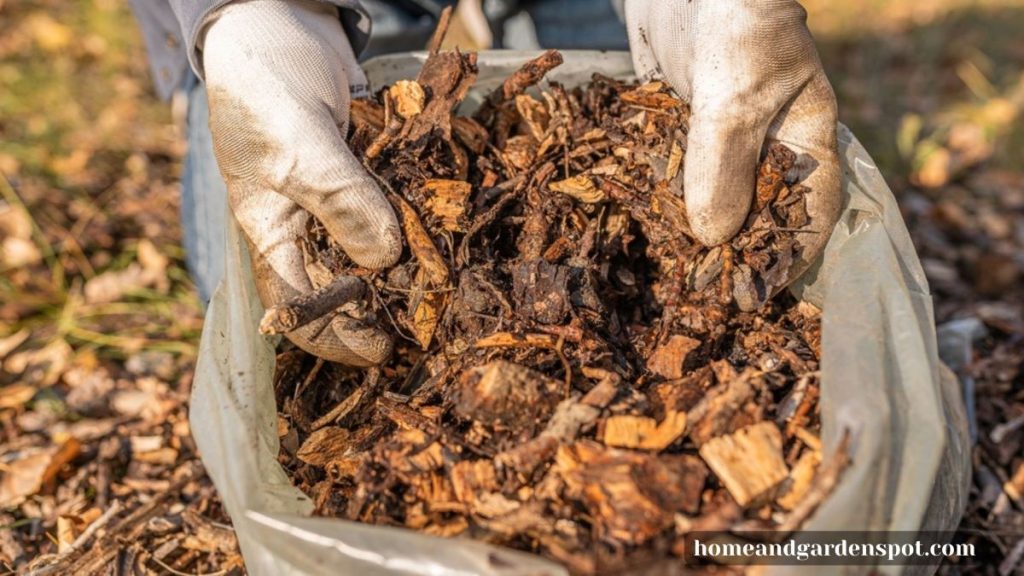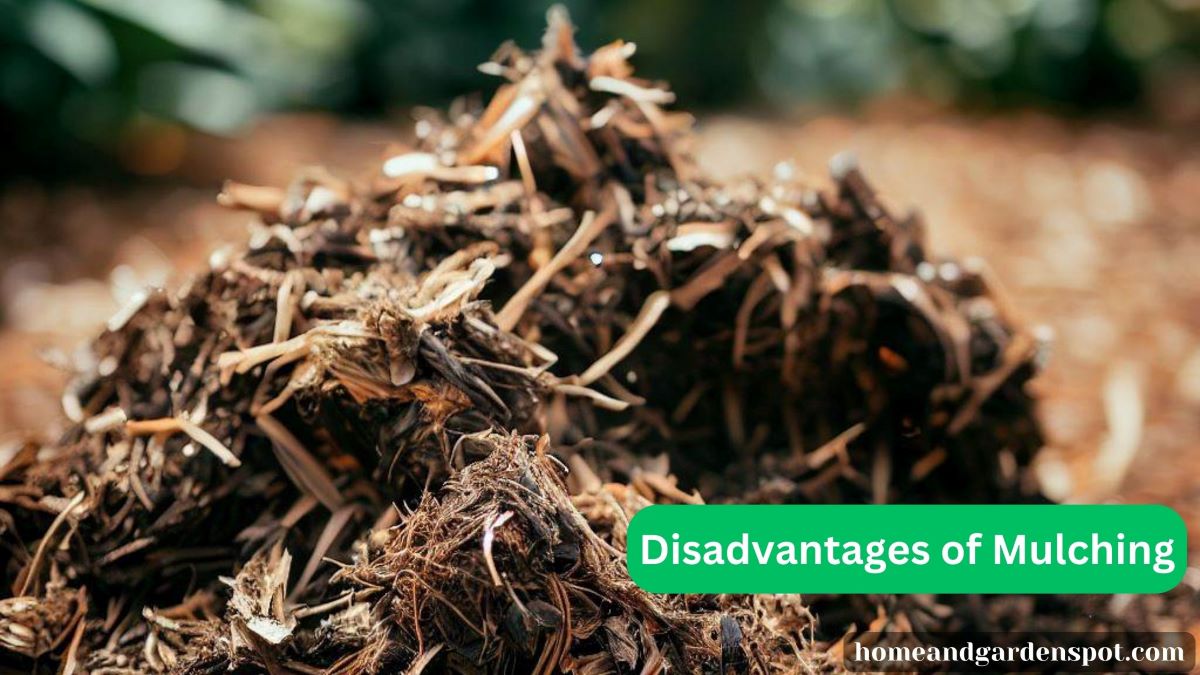As a seasoned gardener, I’ve seen it all – the good, the bad, and the (slightly) ugly when it comes to mulching.
Sure, everyone knows mulch helps retain moisture and keeps weeds at bay.
But hold on to your trowel, because there’s more to the story!
This guide will unveil the disadvantages of mulching and equip you with the knowledge to navigate them like a pro.
So, grab your gardening gloves, because we’re about to dig into the not-so-obvious hiccups in mulching.

Disadvantages of Mulching
The disadvantages of mulching include:
1. It causes overheating of the soil
Mulching can help moderate the soil temperature by insulating it from extreme heat or cold.
However, this can also have negative effects on your plants.
For instance, mulching can cause overheating of the soil in summer, which can stress your plants and reduce their growth and yield.
On the other hand, mulching can also delay the warming of the soil in spring, which can affect the germination and emergence of your seeds or seedlings.
2. It can affect the aeration and drainage of the soil
Mulching can add weight to the soil surface, compressing the soil and reducing its porosity.
This can affect the aeration and drainage of the soil, as well as your plants’ root growth and development.
Compacted soil can also make it harder for water and nutrients to reach your plants.
3. Weed management challenges
Another disadvantage of mulching is that it can pose weed management challenges.
Mulching can help suppress weeds by blocking sunlight and preventing weed seed germination.
This may not always be effective, depending on the type and thickness of the mulch.
Some mulches may not provide enough coverage or decompose quickly, allowing weeds to grow through or around them.
Moreover, some mulches may even contain weed seeds, which can introduce new weeds.
In addition, mulching also requires maintenance to keep weeds at bay.
You must constantly monitor your mulch for weed breakthroughs and remove them promptly before they spread or set seeds.
4. It causes nutrient and pH imbalances
A third disadvantage of mulching is that it can cause nutrient and pH imbalances in your soil.
Mulching can affect your plants’ nutrient availability and uptake in different ways.
For example, decomposing organic mulches can deplete soil nitrogen as they break down, reducing plant growth and health.
This is known as nitrogen tie-up or immobilization.
Add extra nitrogen fertilizer to your soil or choose a low-carbon-to-nitrogen ratio mulch to prevent this.
5. Mulching can also alter the pH level of your soil
Some mulches may acidify or alkalize your soil over time, which can affect the suitability of your soil for certain plants.
For instance, pine needles or sawdust can lower the pH of your soil, making it more acidic.
This may benefit acid-loving plants like blueberries or azaleas but harm alkaline-loving plants like cabbages or lilacs.
On the other hand, limestone or oyster shells can raise the pH of your soil, making it more alkaline.
This may benefit alkaline-loving plants like lavender or thyme but harm acid-loving plants like rhododendrons or hydrangeas.
6. It can interfere with moisture management in your garden
Mulching can help conserve moisture in your soil by reducing evaporation and runoff.
However, this can also have drawbacks for your plants.
For example, thick layers of mulch can hinder water infiltration into the soil, especially if they are compacted or hydrophobic (water-repellent).
This can result in surface runoff or ponding that can erode your soil or drown your plants.
7. It can cause moisture problems
Another main challenge of mulching is that it can affect the soil’s moisture level.
Mulching can create several problems, such as:
a) Water Infiltration
Mulching can interfere with the water movement in the soil, depending on the type and thickness of the mulch.
Thick layers of mulch can hinder water penetration and prevent water from reaching the plant roots.
This can result in water stress and reduced plant growth.
Moreover, thick mulch layers can increase the potential for surface runoff, eroding the soil and washing away nutrients and pesticides.
b) Excessive Moisture Retention
Mulching can also trap too much moisture in the soil, especially in wet or humid conditions.
Excessive moisture retention can create anaerobic conditions in the soil, reducing soil oxygen levels and affecting root respiration.
Excessive moisture retention can also increase the risk of root rot and other diseases, such as damping-off, crown rot, or phytophthora.
8. It can negatively affect the appearance of the garden
Mulching can look messy or unappealing, depending on the type and quality of the mulch.
Some types of mulch, such as corn cobs or newspaper, can look cheap or unsightly.
Some types of mulch, such as wood chips or bark, can fade or discolor over time.
Some types of mulch, such as gravel or rubber, can look unnatural or out of place.
Moreover, some types of mulch can also attract litter or debris that can spoil the garden’s look.
9. It can cause difficulty with certain plants
Mulching can also affect the performance and health of certain plants.
Some plants, such as bulbs, cacti, succulents, or alpine, may not thrive under mulch.
These plants require well-drained soil and may suffer from excess moisture or rot under mulch.
Some plants, such as roses, azaleas, rhododendrons, or blueberries, may require special care when mulched.
These plants are sensitive to pH changes and may need acidifying amendments to counteract the alkalizing effect of some types of mulch.
10. It can be costly and labor-intensive
Mulching can be expensive, depending on the type and quantity of the mulch.
Some types of mulch, such as compost, manure, or peat moss, can be free or cheap if you make them yourself or obtain them from a local source.
However, some types of mulch, such as wood chips, bark, or stone, can be pricey if you buy them from a store or a supplier.
Moreover, some types of mulch, such as plastic or rubber, can have hidden costs, such as disposal fees or environmental impacts.
Also, mulching can be physically demanding and time-consuming, depending on the type and quantity of the mulch.
Some types of mulch, such as straw or newspaper, can be easy to apply and spread by hand but others may require the use of tools.
What are the Disadvantages of Colored Mulch?
Colored mulch is dyed with a colorant, usually red, black, or brown.
Colored mulch can have some disadvantages, such as:
1. Reducing the amount of nitrogen available to plants
Colored mulch is usually made from wood chips treated with a dye.
Wood chips take longer to decompose than other organic materials and consume more nitrogen from the soil in the process.
This can reduce the nitrogen availability for the plants and affect their growth and health.
2. Leaching color into the soil
Colored mulch can also leach its color into the soil, especially when wet or exposed to sunlight.
This can alter the pH and nutrient balance of the soil and potentially affect the taste and quality of fruits and vegetables.
3. Absorbing heat from the sun
Colored mulch can also absorb more heat from the sun than natural mulch, especially dark colors like black or brown.
This can increase the soil temperature and make the plants more prone to heat stress or drought.
4. Harming people and animals
Colored mulch can also pose health risks for people and animals who come in contact with it.
Some dyes used in colored mulch may contain harmful chemicals, such as arsenic, lead, or chromium, which can leach into the soil or water and cause toxicity or cancer.
Some animals, such as dogs or birds, may also ingest colored mulch and suffer from digestive problems or poisoning.

Conclusion
Now that you’ve uncovered the disadvantages of mulching, do you still want to get your hands dirty (in a good way)?
Mulch can be a game-changer for your garden, but remember, knowledge is power.
So, tell me in the comments below! What kind of mulch are you most excited to try?
Have you encountered any mulching mishaps?
Share your gardening triumphs (and maybe a few lessons learned) to help us all cultivate thriving green havens. Happy mulching!

Leave a Reply